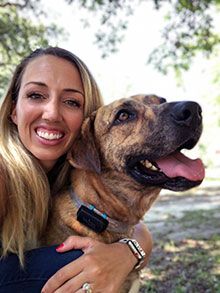How all-day data helps treatment
The veterinary team at this Florida hospital has been trying wearable sensors for patients to get round-the-clock, at-home data for dermatology, nutrition and post-surgery issues.

Wearable collars and other activity monitors offer veterinary teams more data to check for continuing clinical signs and the success of treatments. (Adobe Stock)Davis Animal Hospital in Pensacola, Florida, began life in 2012 as a small animal practice with six employees. It has grown quickly since then and now offers surgical referral services, luxury boarding and a pet spa. Much smaller has been the addition of placing wearable trackers on select patients.

Soldier, a patient at Davis Animal Hospital, suffered from severe allergies (pictured here with hospital director and owner April Ball). He was put on a veterinary dermatology diet and given topical treatment. He was also fitted with a Vetrax collar to assess how effective the treatment regime was proving and to alert the veterinary team on any necessary adjustments. Soldier is now comfortable and happy. (Photo courtesy of author)
“We were introduced to the Vetrax monitors at the end of 2017 and were immediately keen to explore whether it could be a new tool to help us monitor the health of our patients,” says April Ball, hospital director and owner of Davis Animal Hospital. “So far, we've used it on a range of dogs, particularly those suffering from allergies, those needing to lose weight, and some recovering from surgery.”
Dermatology: Watching scratching and biting
Want to know when a patient is itchy? Clients can only tell you what they've seen when they've been around their pet. A wearable sensor watching for shaking has helped the veterinary team uncover some potential allergy culprits in a dog's busy day.
Ball says the Vetrax sensor offers a 24/7 view of the dog's behavior to help her devise the most appropriate treatment regime.
“For instance, one of our patients was always much itchier on a Saturday than any other day,” she says. “We asked his owner what he did differently on Saturdays, and it turned out that it was the day that he went to the neighborhood park. We were able to suggest bathing him or at least wiping down his feet after these visits to help reduce his itchiness.”
Ball says the sensors also come in handy for checking that patients with skin problems or ear infections are scratching or shaking less during or after treatment.
Nutrition: Counting activity time
You can't watch an obese or overweight patient all the time, so calorie counting and exercise monitoring is typically up to clients to self-report. But many clients are already used to counting their steps on their own wearables, so a leap to a pet monitor doing the same thing has worked for some weight-loss cases, according to Ball.
“It's encouraging for pet owners to be able to see an accurate measure of their pet's activity,” she says. “We feel that it also helps to make them more accountable for their pet's activity goals and that increases their motivation.”
Surgery: Checking movement
Post-surgery patients run the gamut, Bell says, from pets after orthopedic surgeries on strict crate rest and others on aggressive physical therapy programs. The monitor helps the veterinary team check on the right activity amount for that patient at home.
“If we notice that a patient on ‘strict rest' is showing too much movement on our screen, we can reach out quickly to the client to remind them how critical it is to keep their pet crated to avoid the risk of orthopedic implant failure,” she says. “Equally, if a patient that needs daily walking for physical therapy is showing a low activity level, we can again check with the client as to what may be holding them back from reaching their physical therapy goals. If we had to wait weeks between appointments to find out how things were going, recovery for some of our patients could take much longer.”
Rebecca George is principal at George PR.